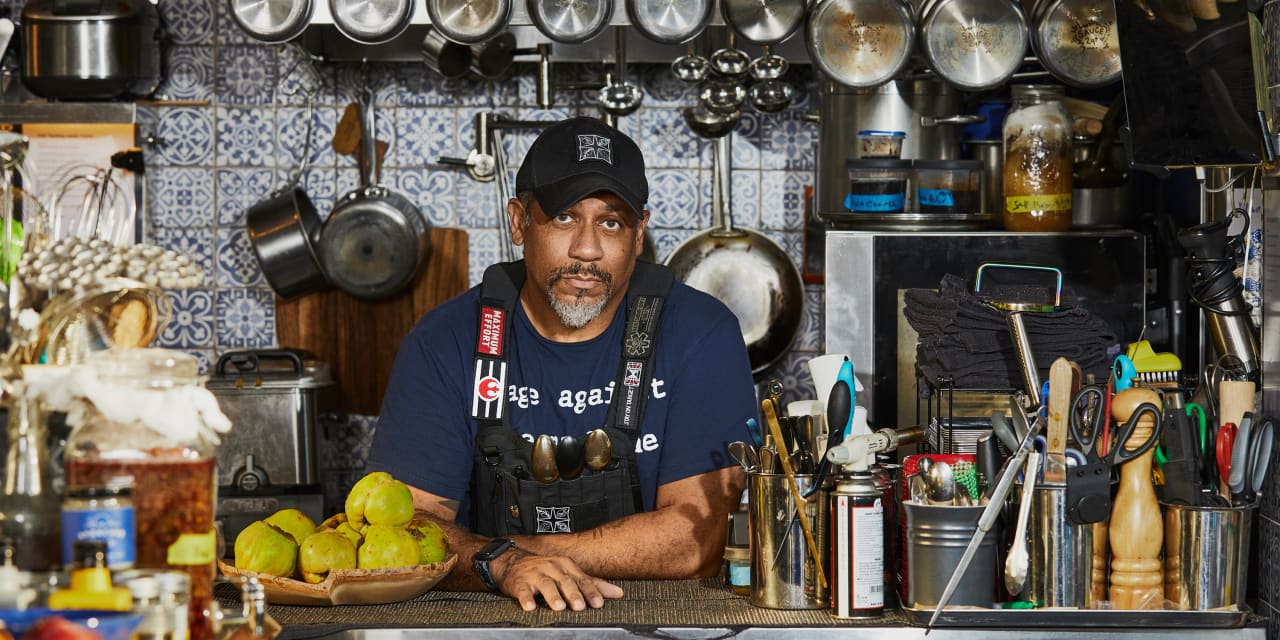New York City-based chef Russell Jackson says finding financing for his restaurants has always been a balancing act. But the current combination of high interest rates, high inflation and tight credit has made it more precarious than ever.
Since his latest venture, a fine-dining restaurant called Reverence, opened in late 2019, Jackson has kept the operation running with a changing concoction of personal savings, Small Business Administration loans, Paycheck Protection Program funding, private grants, community donations and his first-ever corporate credit card, which is already maxed out.
“We went from manageable to unmanageable very, very quickly, because the interest rates basically quadrupled,” Jackson told Barron’s from his Harlem-based restaurant.
Jackson, a seasoned restaurateur who once appeared on Iron Chef, is among millions of small business owners battling to stay afloat amid rising economic headwinds and slowing consumer demand. In less than four years, small firms—more vulnerable to economic whims than their larger counterparts—have been forced to navigate pandemic shutdowns and restrictions, supply-chain slowdowns, labor shortages and rising prices.
Now there’s a new challenge: tightening credit conditions, which have driven up interest-rate payments and made it difficult for entrepreneurs to secure the loans they need to expand. Roughly one in five small businesses view rising interest rates as the top challenge, and half of all small firms are delaying plans to expand because of those rates, says Tom Sullivan, vice president of small business policy with the U.S. Chamber of Commerce, citing survey data jointly collected by the chamber and MetLife.
Access to financing is crucial for small businesses because it enables them to grow and hire additional workers. Small firms are responsible for roughly two-thirds of all net new jobs and in recent years have accounted for 44% of all economic activity, so their resilience is key to the elusive soft landing Fed officials hope to achieve.
The headwinds dogging small businesses highlight the risks to the economy if the Fed keep rates too high for too long. So far, data has largely suggested that the broader economy remains strong: Unemployment is below 4%, household balance sheets are strong, and growth soared in the third quarter to a more than a 5% annual rate.
Many small businesses, in contrast, are offering warning signs. The net share of business owners reporting higher sales in the past three months, compared to the prior period, just posted its lowest reading since July 2020, according to the November survey from the National Federation of Independent Business. The federation’s Optimism Index has also ticked lower for each of the past four months and is below where it stood in April 2020, in the depths of the coronavirus pandemic. More than half of small business owners believe the U.S. is already in a recession.
Some economists warn that small business troubles could be an early indicator for where the broader economy is headed. “What might be happening is that small businesses, which are often at the forefront of the economy … might be seeing conditions on the ground deteriorate a little bit ahead of what the data is picking up,” says Charlie Dougherty, a senior economist with Wells Fargo.
Fed officials have begun to air similar concerns. While the central bank wants to see some slowdown in economic activity and in the labor market, Fed Gov. Lisa Cook said in a November speech that she is “attuned to the risk of an unnecessarily sharp decline.” She said small businesses borrow for shorter terms than larger firms and are therefore facing higher rates sooner as they roll over their loans.
In 2013, Samantha Snabes co-founded the Texas-based firm re:3D, a company that manufactures and sells 3-D printers that can use traditional pellets or plastic waste to print objects. As the 28-person team has grown, it has pushed its main factory over capacity.
Snabes is now looking to relocate and purchase a new plant to help the company scale up. But the cost of financing has given her pause.
“We’re looking at lines of credit and other things, and the interest rates have just been insane,” Snabes told Barron’s. “So I’ve shied away from doing that.”
The data suggests she isn’t alone. Small businesses are facing tighter lending conditions than large and mid-market firms when it comes to the maximum size of credit lines and collateralization requirements, the Fed’s most recent Senior Loan Officer Opinion Survey on bank lending practices shows.
At the same time, Bank of America Institute data shows credit card balances are rising among small businesses even as spending stays more or less flat, suggesting that more firms are using their cards as a source of financing. Some 30% of small businesses are now using credit cards for financing, and overall credit-card debt levels for these firms are up 20% from the pre-pandemic years, according to the Intuit QuickBooks Small Business Index annual report.
That could indicate more small firms are facing trouble and growing more desperate for outside financing, says Ufuk Akcigit, a University of Chicago economics professor who led development of the QuickBooks index.
“The variable cost of financing through credit cards is very high—and that’s why normally it’s not the first means that people would use,” Akcigit says. “But of course, when things are tight, what will they do? They switch to credit cards.”
Write to Megan Cassella at [email protected]
Read the full article here


